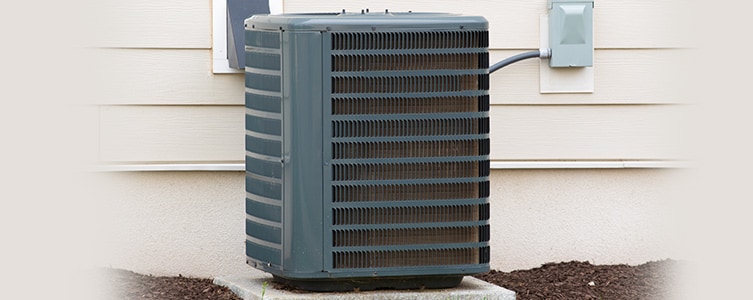
When shopping for heating and cooling equipment, such as an air conditioner or heat pump condensers, energy efficiency ratings are important to keep in mind. Not only do they impact your utility bills and overall feeling of comfort, but the U.S. Department of Energy (DOE) regulates the type of equipment you're allowed to install based on these ratings.
As of January 1st, 2023, The U.S. Department of Energy (DOE) is increasing minimum energy efficiency requirements for air conditioners and heat pumps. This includes a complete overhaul of previous efficiency ratings to better reflect real-world conditions. It uses the new "M1" test method, which increases the system's external static pressure for more realistic results.
To accomplish this, the DOE has mandated new testing procedures that change the efficiency ratings scale. For example, an air conditioner with a previous rating of 14 SEER (see below for more details) will now have a rating of 13.4 SEER2.
Even though it looks like the efficiency level has decreased, in practice the new testing scale means it has increased. The most visible change will be one of terminology. All the old efficiency measures (SEER, EER, HSPF) will now add a "2" to their name (i.e., SEER2, EER2, HSPF2).
Furthermore, the DOE divides the United States into three efficiency regions: North, Southwest, and South. Specific efficiency requirements for each of these regions are listed in the table below.

In the North region, all equipment built after January 1, 2023 must abide by the new minimum efficiency regulations. Equipment built before that cutoff date may still be installed, however.
In the Southwest and South regions, requirements are stricter. No air conditioning equipment can be installed after January 1, 2023 that does not meet the new minimum efficiency requirements. This applies even to equipment built and purchased before that date.
For example, if you purchased an air conditioner in December 2022 that does not meet minimum requirements and did not install it before January 1st, you can no longer do so. Single-packaged heat pumps built prior to January 1, 2023 that are 14.0 SEER may still be sold and installed after that date.
The DOE updates minimum efficiency requirements every seven years or so, with the previous updates having taken effect in 2015.
It's worth mentioning another major industry change. Beginning on January 1, 2025, residential HVAC equipment designed for R-410A refrigerant can no longer be manufactured. Most manufacturers are adopting R-454B or R-32 refrigerants to comply with the regulations. These are commonly referred to as A2L refrigerants, referencing their low flammability.
If you have an existing heat pump or air conditioner installed that doesn't meet the minimum efficiency requirements, no action is necessary. However, the next time you decide to upgrade or replace your system, you will be required to follow the new efficiency standards or face possible fines.
There are three main energy efficiency ratings for air conditioners and heat pumps and one for boilers and furnaces.
Seasonal Energy Efficiency Ratio 2 (SEER2) is the efficiency rating found on air conditioners and mini split systems. It measures cooling output in BTUs divided by energy consumption in watt hours. SEER2 calculates energy efficiency at a variety of temperatures and yields a seasonal average. It is commonly used in climates with fluctuating temperatures, like the north.
SEER2 = [Cooling Output / Energy Consumption]
(Measured at Multiple Temperatures)
A good SEER2 rating for air conditioners is anything above 16. For mini split systems, which are inherently more efficient, a good SEER2 rating is above 20.
Energy Efficiency Rating 2 (EER2) is calculated similarly to SEER2, except it uses a single "peak day" temperature of 95°F. This is meant to represent the hottest days, which will strain the unit most. For this reason, EER2 is commonly used in hotter climates like the Southwest, where temperatures consistently stay in this upper range.
EER2 = [Cooling Output / Energy Consumption]
(Measured at 95°F)

Shop: Air Conditioner Components
Heating Season Performance Factor 2 (HSPF2) measures heat pump efficiency. It measures heating output in BTUs divided by energy consumption in watt hours.
HSPF2 = [Heating Output / Energy Consumption]
A good HSPF2 rating is 9 or higher. In colder climates, a higher HSPF2 rating will serve you better since your heat pump will be working harder when used.
Annual Fuel Utilization Efficiency (AFUE) measures the amount of heat produced by your furnace or boiler compared to the total amount of energy it uses. The resulting number is expressed as a percentage.
AFUE = [Heating Output / Energy Consumption] x 100
The higher the AFUE percentage, the more efficiently your furnace or boiler converts energy into useable heat. The DOE has made 80% the minimum AFUE rating for new furnaces and boilers.
While some may find the concept of minimum efficiency requirements overbearing, they ultimately benefit you directly. A higher efficiency rating means your equipment is creating more usable heating and cooling btu's for less energy, which translates into lower monthly energy bills. On a larger scale, higher efficiencies benefit the environment by reducing the toxic byproducts created during the energy production process.
If you have any questions about efficiency ratings and how they impact your next heating or cooling purchase, please contact us to speak with a product expert.